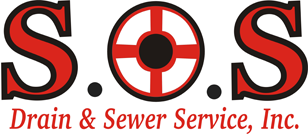Repeated sewer line back-ups are more than a nuisance. They can damage your home. It’s best to address main sewer line problems quickly. The causes of main sewer line backups tend to get worse over time.
If you’re not sure that your problem is a main sewer line backup, we have another post that describes the signs of a sewage backup. Here are the common reasons main sewer line backups happen again and again.
The Main Sewer Line Is Damaged
A broken sewer line can’t do its job of carrying sewage away from your home. Sometimes, it’s shifting soil or settling that breaks the line.
Older lines may deteriorate with the passage of time. In homes over 50 years old, it’s often the case the original cast-iron sewer line has reached the end of its lifespan.
Certain types of pipes are more susceptible to particular kinds of damage. Clay pipes are porous and more likely to provide the moisture to attract tree roots. Cast iron pipe is subject to corrosion from long-term exposure to acidic soil, chemical drain cleaners, and grease.
A sagging sewer line has a portion that has sunk lower than the rest of the pipe. These lines can’t flow freely because everything becomes trapped in the lower section of the pipe.
Tree Roots Could Be to Blame
Sewer lines with holes, compromised joints, or cracks offer access to nutrients from the sewage and water. These are the conditions shrub and tree root thrive in, resulting in rapid root growth.
Since the pipe usually already has openings, it’s easy for the roots to enter the pipe and eventually block it. Also, the weight of tree roots can crush a sewer line.
If your property does not have trees or shrubs, you can’t rule out tree roots as the source of your problem. Roots from the trees in your neighbor’s yard or in nearby public space may have invaded your property. It’s not unusual for the length of tree roots to extend two or three times the breadth of the tree’s branches.
The Toilet Doubles as a Trash Can
Flushing anything besides toilet paper and human waste greatly increases the possibility of clogs. Diapers, feminine hygiene products, and facial tissues can obstruct your main sewer line.
Frequently, personal wipes, even those labeled flushable or septic-safe, are what’s blocking the main sewer line. Most wipes don’t break down quickly the way toilet paper does. As Today reports, there are no legal requirements manufacturers have to meet to call their wipes flushable.
FOG Has Caused a Clog
Fats, oils, and grease (FOG) should never go down household drains. Grease hardens in pipes and clogs them. Grease can also trap things like tissues and wipes in the sewer line.
You may have heard running hot water or operating your garbage disposer prevents grease from blocking your pipes. Neither is true.
There are ways to get rid of grease that don’t involve clogging your sewer line with it. Give the grease a chance to cool down. Then, you can put it in a disposable container you can seal like a margarine tub, milk jug, or peanut butter jar. Now you can discard your grease in the trash.
Before washing dishes, it’s a good idea to put food scraps in the trash rather than the garbage disposal. Also, using a paper towel to absorb grease remaining on pots and pans keeps that fat out of your plumbing.
We can help you figure out why your main sewer line keeps backing up. Let’s find a solution to your problem. Contact us today.



